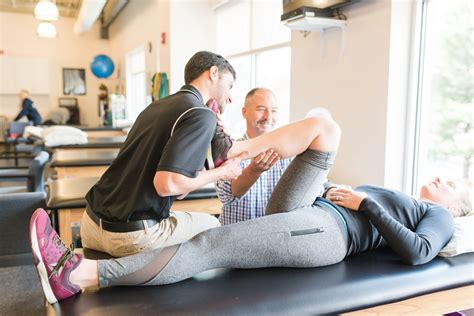Intro
The role of a physical therapist is multifaceted and rewarding, requiring a deep understanding of the human body, its mechanics, and the capacity to heal and adapt. Physical therapists play a crucial role in healthcare by helping patients manage pain, recover from injuries, and improve mobility. If you're passionate about health, wellness, and helping others, pursuing a career as a physical therapist could be incredibly fulfilling. Here's a step-by-step guide to help you embark on this journey.
Step 1: Earn a Bachelor's Degree

The first step towards becoming a physical therapist is to earn a bachelor's degree from an accredited institution. While a specific undergraduate major is not required for physical therapy school, taking courses in biology, chemistry, physics, and mathematics can be beneficial. Many aspiring physical therapists choose to major in fields like exercise science, biology, or psychology. It's also important to maintain a high grade point average (GPA), as admission to physical therapy programs can be competitive.
Key Courses to Focus On
- Anatomy and Physiology
- Biomechanics
- Kinesiology
- Statistics
- Psychology
Step 2: Gain Observation Experience

Gaining observation experience in a physical therapy setting is crucial. It not only gives you insight into the daily life of a physical therapist but also demonstrates your commitment to the profession. Many physical therapy clinics offer volunteer or shadowing opportunities. This experience can also be valuable when applying to physical therapy programs, as it shows that you have a practical understanding of the field.
Tips for Gaining Observation Experience
- Start Early: Try to gain experience as early as possible, even during your freshman year of college.
- Be Proactive: Reach out to physical therapists in your area and ask if they would be willing to let you observe their work.
- Keep a Journal: Documenting your experiences can help you reflect on what you've learned and prepare you for graduate school applications.
Step 3: Take the Graduate Record Examination (GRE)

Most physical therapy programs require applicants to take the Graduate Record Examination (GRE). The GRE is a standardized test that measures verbal reasoning, quantitative reasoning, and analytical writing skills. Preparation is key, and it's recommended to study for several months before taking the test. Some programs may also require additional exams or assessments.
GRE Preparation Tips
- Start Early: Give yourself plenty of time to prepare for the GRE.
- Use Study Materials: There are many study guides and online resources available to help you prepare.
- Practice Tests: Taking practice tests can help you understand the format of the exam and identify areas where you need to focus your studying.
Step 4: Attend a Doctor of Physical Therapy (DPT) Program

The next step is to apply to and attend a Doctor of Physical Therapy (DPT) program accredited by the Commission on Accreditation in Physical Therapy Education (CAPTE). These programs typically take three years to complete and include both classroom instruction and clinical training. The curriculum covers a wide range of topics, from the basic sciences to clinical practice.
What to Expect in a DPT Program
- Classroom Instruction: You'll study subjects like anatomy, biomechanics, and pharmacology.
- Clinical Training: You'll gain hands-on experience in a clinical setting under the supervision of licensed physical therapists.
- Research: Many programs require students to participate in research projects.
Step 5: Complete Clinical Internships

As part of your DPT program, you'll complete clinical internships. These internships provide valuable hands-on experience and the opportunity to apply theoretical knowledge in real-world settings. They also give you a chance to work with patients and develop your clinical skills under the supervision of experienced physical therapists.
Clinical Internship Tips
- Be Open-minded: Be willing to learn and adapt to different clinical environments and patient populations.
- Ask Questions: Don't hesitate to ask questions or seek feedback from your supervisors.
- Reflect on Your Experiences: Keep a journal or reflect on your experiences to identify what you've learned and areas for improvement.
Step 6: Pass the National Physical Therapy Examination (NPTE)

After graduating from a DPT program, the next step is to pass the National Physical Therapy Examination (NPTE) to become licensed. The NPTE is a comprehensive exam that tests your knowledge and skills in areas like patient management, professional responsibilities, and scientific foundations.
NPTE Preparation Tips
- Use Study Materials: There are many study guides and online resources available to help you prepare for the NPTE.
- Practice Tests: Taking practice tests can help you identify areas where you need to focus your studying.
- Stay Calm: It's normal to feel nervous, but try to stay calm and focused during the exam.
Step 7: Pursue Residency or Fellowship Programs (Optional)

After becoming licensed, some physical therapists choose to pursue residency or fellowship programs for specialized training. These programs can last from one to three years and provide advanced training in a specific area of physical therapy, such as sports physical therapy or pediatric physical therapy.
Benefits of Residency or Fellowship Programs
- Advanced Training: You'll receive specialized training that can enhance your clinical skills and knowledge.
- Networking Opportunities: These programs provide opportunities to network with other professionals in your field.
- Career Advancement: Completing a residency or fellowship program can be beneficial for career advancement.
If you're passionate about helping others and are interested in the human body and its functions, becoming a physical therapist could be an incredibly rewarding career path. By following these steps and dedicating yourself to your education and training, you can set yourself up for success in this field.
What is the average salary for a physical therapist?
+The average salary for a physical therapist can vary depending on factors like location, experience, and setting. However, according to the Bureau of Labor Statistics, the median annual salary for physical therapists in the United States was over $95,000 in May 2020.
How long does it take to become a physical therapist?
+Becoming a physical therapist typically takes about 7-8 years after high school. This includes 4 years of undergraduate studies and 3 years of graduate studies in a Doctor of Physical Therapy (DPT) program.
Do physical therapists need to be licensed?
+Yes, physical therapists need to be licensed to practice in the United States. Licensing requirements typically include graduating from a CAPTE-accredited DPT program and passing the National Physical Therapy Examination (NPTE).
We hope this guide has provided you with a comprehensive overview of how to become a physical therapist. Whether you're just starting your educational journey or are already on the path to becoming a physical therapist, remember that dedication, hard work, and a passion for helping others are key to success in this rewarding field.
